Aleister Crowley (12-10-1875 - 01-12-1947) British composer
Aleister Crowley (born Edward Alexander Crowley) was one of the most influential occultists of all times but he also composed chess problems. This is his first published work:
Crowley, Aleister
The British Chess Magazine, Dec 1893 (no. 987)
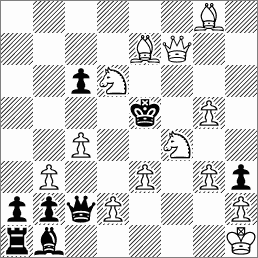
Show Solution1.Qg6!
1...Qxg6 2.Sxg6+ Bxg6#
1....Qf5 2.Qxf5+ Bxf5#
1...Qe4+ 2.Qxe4+ Bxe4#
1...Qd3 2.Sxd3+ Bxd3#
1...Q ~ 2.Qf5+ Bxf5#
1...c5 2.Qxc2 Bxc2#
Peter F. Copping (12-10-1922 - 18-12-1989) British composer
Peter Copping composes strategic direct movers in 2 and 3 moves.
Copping, Peter F.
Observer, 1958
1
st Prize
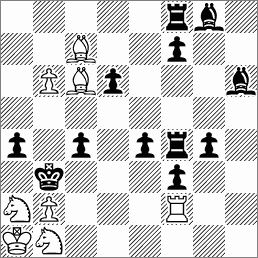
Show Solution1.Sb1-a3 ! (2.Sa3-c2 [3.Sc2-d4/Sa2-c1#] 2...c4-c3 3.Bc6-d5#)
1...e4-e3/f7-f5 2.Bc7xd6 ~ 3.Sa2-c1#
1...Bh6-g7 2.Bc7xd6 (3.Sa2-c1#) 2...Bg7xb2+ 3.Rf2xb2#
1...Rf4-f6 2.Bc6-d5 ~ 3.Bd5xc4#
1...Rf4-f5 2.Bc6xe4 ~ 3.Be4-c2#
1...f7-f6 2.Rf2-c2 ~ 3.Rc2-c3#
Михаил Павлович Кузнецов (12-10-1941 - 27-11-2007) Russian composer and FIDE Master (Mikhail Pavlovich Kuznetsov)
Mikhail Kuznetsov composed direct mates in 3 and more moves.
Кузнецов, Михаил Павлович
64 — Шахматное обозрение 1985 (21/70)
1
st Prize
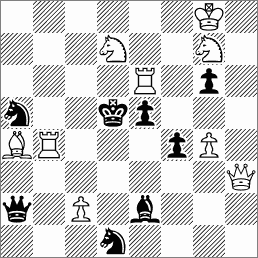
Show Solution1.Qh3-a3 ! (2.Sd7-b6+ Kd5-c5 3.Rb4-c4#)
1...Qa2-c4 2.Re6xe5+ Kd5-d6+,Kd5-d4+ 3.Rb4xc4,Sg7-e6#
1...Qa2xa3 2.Re6xe5+ Kd5-d6 3.Sg7-e8#
1...Be2-c4 2.Qa3-f3+ Kd5-d4, e5-e4 3.Qf3-d3, Qf3xe4#
1...Sa5-c4 2.Ba4-c6+ Kd5-d4 3.Re6-d6#
Some surprising pin mates.
Jürgen Fleck (12-10-1960) German composer
Jürgen Fleck is o.t.b. IM and study composer. His
1st prize in Tchekover-90 MT, 1999 is an interesting theoretical endgame R vs R+P and
on Wikipedia you can find one of his best works.
Fleck, Jürgen
Hastings Ty EG, 1995
5
th Commendation

Show Solution1. Sc4+
{1. Re8+ ? Kf5 2. Rf8+ Ke6 ; 1. Rb5+ ? Ke6}
1... Ke6
{1... Rxc4 2. Rb5+ [2. d8=Q ? Rh3+] 2... Ke6 3. d8=Q Rh3+ 4. Kg7 Rg4+ 5. Rg5 +-}
2. d8=S+ Kd7 3. Sxa3 Rh4+ 4. Kg7
{4. Kg6 ? Rh8 5. Rb7+ Kc8 = ; 4. Kg8 ? Re4 5. Kf7 Re7+ 6. Kg6 Re8 =}
4... Rg4+ 5. Kf8
{5. Kh6 ? Rg8 or 5. Kh8 ? Re4 or 5. Kf7 ? Rf4+ 6. Kg7 or 5. Kh7 ? Rh4+ 6. Kg7}
5... Ra4 6. Sb5
{6. Sb1 ? Kc7; 6. Sc2 ? Kc7 =}
6... Ra8 ! 7. Rb7+ !
{7.Rxa8? stalemate}
7...Kxd8 8. Sa7 ! wins.
Reto Aschwanden (12-10-1974) Swiss composer and Grandmaster
 |
Reto Aschwanden
[swisschess.ch [broken link] ] |
In 2010 Reto Aschwanden became the youngest composing Grandmaster ever, at the age of 36. He is most known for his direct mate problems, often amazing cycles (the so-called
Letter Themes) with strategic motives and fairy pieces and conditions, as well as for his proof games, which earned him many FIDE-Album points. He won the WCCI for fairy problems in 2001-03 and for retro problems in 2004-06.
Juraj Lörinc presented 5 of his fairy twomovers in 2000
on his website with Reto's own remarks.
Aschwanden, Reto
9
th TT Chess Composition Microweb, 17
th Jun 2002 (No. 1)
2
nd Prize
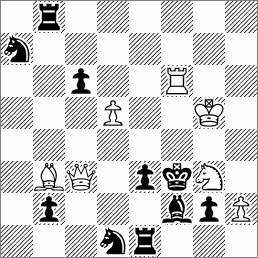
Show Solution1.d6? A (2.Qxc6# B)
1...Sxc3 a 2.Bd1# C
but 1...c5!
1.Qc3~? (2.Bxd1# C)
but 1...Sc3! a
1.Qxc6! B (2.Bxd1# C)
1...Sc3 a 2.d6# A
Djurasevic theme.
Aschwanden, Reto
Die Schwalbe, 2001 (11351)
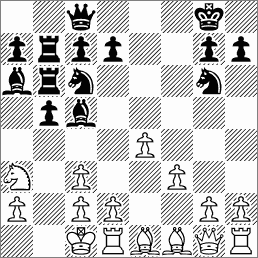
Show SolutionOn which side did White castle?
1. e4 f5 2. Bc4 f4 3. Se2 f3 4. 0-0 fxe2 5. f3 e1=R 6. Kf2 Re3 7. Rh1 Rc3 8. bxc3 b5 9. Ba3 Ba6 10. Bxe7 Qc8 11. Bh4 Se7 12. Qg1 Sg6 13. Bf1 Bc5+ 14. Ke2 0-0 15. Sa3 Rf6 16. Re1 Rb6 17. Kd1 Sc6 18. Kc1 Rab8 19. Rd1 Rbb7 20. Be1 diagram
White castles on the Kingside and then breaks the castle and moves his King to the Queenside to simulate a Queenside castle. A great paradox and no apparent promoted piece on the diagram.
Aschwanden, Reto
feenschach, 2004
1
st Prize
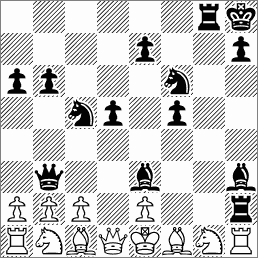
Who could guess at first sight what happened to the white pawns?
Show Solution1. d4 Sa6 2. d5 Sc5 3. d6 a6 4. dxc7 d5 5. f4 Bh3 6. c8=B Qb6 7. f5 Qb3 8. f6 b6 9. fxg7 f5 10. Bb7 Sf6 11. g8=B Bh6 12. Be6 Be3 13. Bec8 0-0 14. Be6+ Kh8 15. Bg8 Rxg8 16. Bc8 Rxg2 17. Be6 Rxh2 18. Bg8 Rxg8 diagram
Excellent invisible annihilation of two white promoted Bishops, thanks to a very subtly motivated Black play and tempo moves of the same Bishops.





Concerning Fleck, Jürgen
ReplyDeleteThe study by Hastings Ty EG, 1995, Fleck himself described one of his best compositions.
The grandiose study h4/h1 (1995) is cooked, because Black wins:
1.d3 Nxd3 2. Bd2 b4 $ 1 3. Nb6 Kg2! (Cook by Siegfried Hornecker and Mario Guida García)
4. c5 b3 5. c6 b2 6. c7 b1 = Q 7. c8 = Q Qxb6 0-1